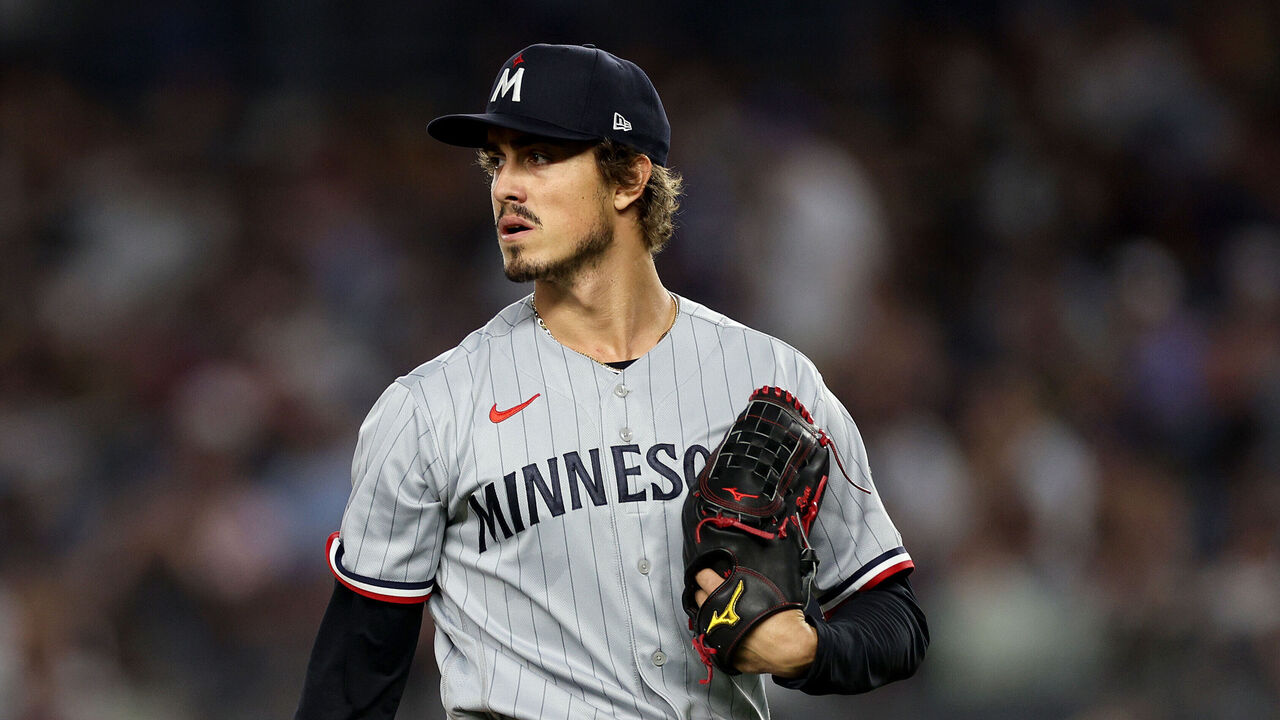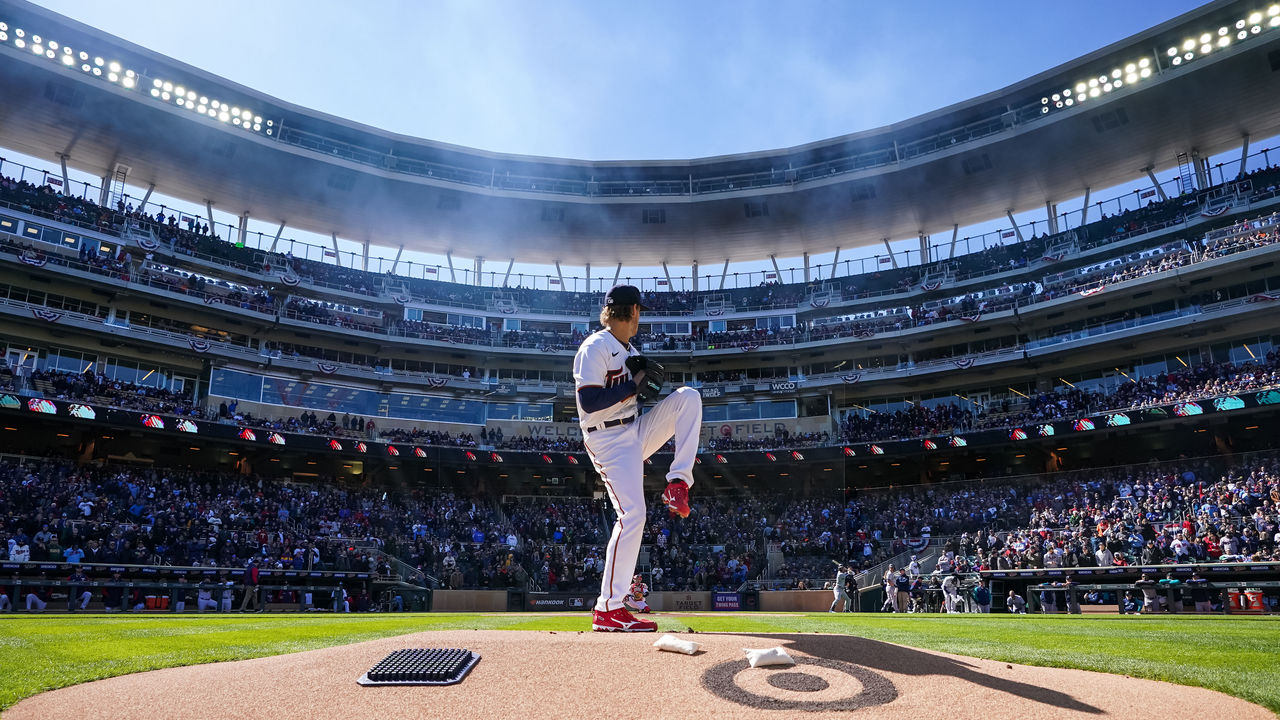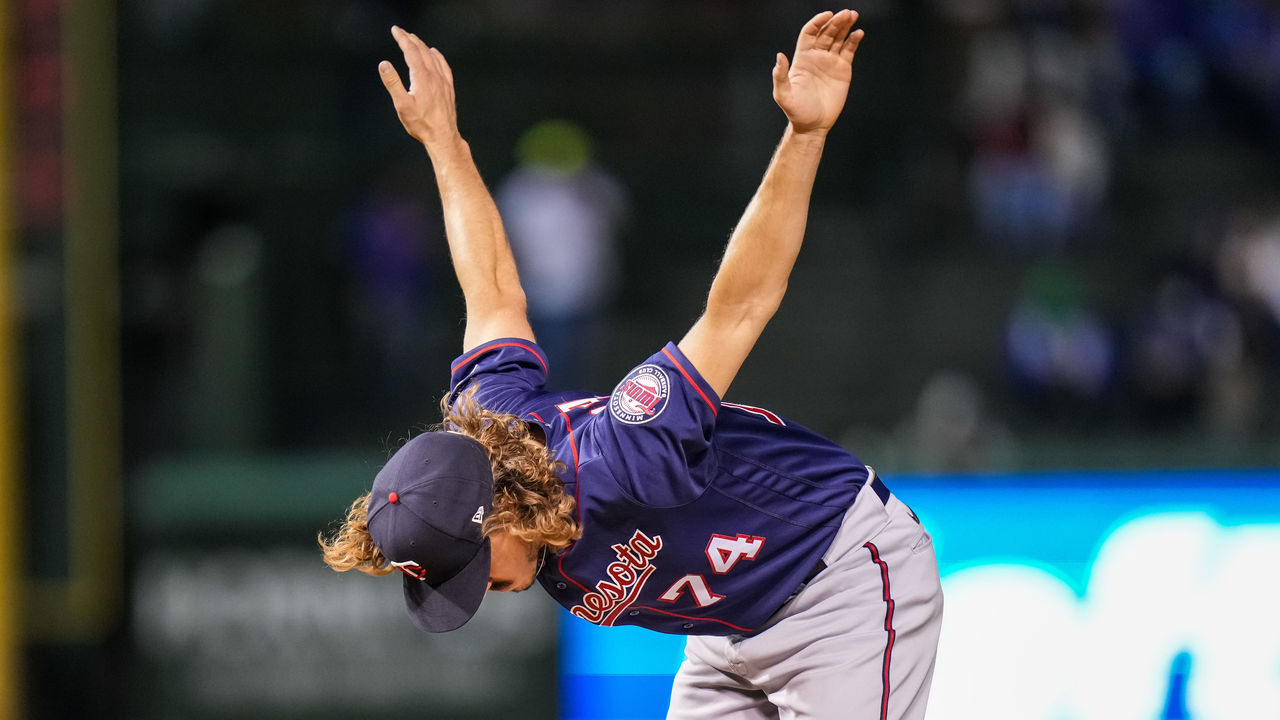Joe Ryan's new bag of tricks is lifting him to another level
Minnesota Twins pitcher Joe Ryan found himself in an impromptu photo shoot before a game in Cleveland last week.
He'd recently helped design Grateful Dead-themed Twins T-shirts for the apparel company Homage, headquartered down the interstate in Columbus. The company's social media coordinator and a photographer had traveled up I-71 hoping he'd agree to model some of the T-shirts. So, on the warning track near the visiting dugout, the affable Ryan pulled over his head (and off again) a number of his screen-printed shirt designs - one featuring a skeleton riding a surfboard, and another with an iconic Grateful Dead bear ice fishing on a frozen Minnesota lake. His walk-up song at Target Field is "Fire on the Mountain" by the band.
As they concluded, as the Guardians took batting practice on the field pregame in the late afternoon, Homage's social media coordinator asked Ryan a few questions for a video interview, wrapping with a basic query:
What do you like about baseball?
It wasn't a question Ryan was often asked anymore - certainly not by beat writers covering the team. Seated in the visiting dugout, he paused for a moment and reflected. He said he liked how the game was always evolving, how players are forced to adapt.
And few have evolved quite like Ryan this season.

Ryan reached the majors with one of the game's best four-seam fastballs. Despite the pitch possessing modest velocity, sitting around 92 mph, it generates a rare amount of swing-and-miss for a four-seamer, ranking in the 85th percentile for whiffs per swing. Ryan's combination of an unusually low release point, and the pitch's rise effect tied to its spin efficiency - and probably some element of deception - makes it one of the game's most effective fastballs. His impeccable command also aids the offering.
But even after the 26-year-old's first full season in the majors last year, an excellent one in which he posted a 13-5 record with a 3.55 ERA and 2.1 WAR, Ryan wanted to get better, to keep evolving.
So right after the Twins concluded their season last fall, he made a trip to Driveline Baseball in suburban Seattle. The independent baseball training facility is known for popularizing velocity-adding programs, its biomechanical evaluations, and ushering in the science of pitch design. A number of professional players now visit, but it was Ryan's first trip.
"Honestly, I probably would have gone to Driveline a long time ago, but having the money now … I wanted to invest in myself a little more," Ryan told theScore.
The former seventh-round pick by Tampa Bay in the 2018 draft out of California State University Stanislaus (a Division II school) wanted to evolve. He wanted not just one pitch makeover, but two.
He knew he wanted a sweeper, the game's en vogue breaking ball. It's the big-bending horizontal breaking ball spreading through the game.
The other pitch he picked up is one that could be the next big thing in the majors - if pitchers can overcome their fear of it.

Driveline was among the first facilities to combine high-speed cameras and spin-tracking tech to create the science of pitch design. It took the guesswork out of learning a new pitch. It made sense to travel there.
Ryan asked the Twins if it was OK to seek outside help and they signed off on the plan. Two other Minnesota arms, Caleb Thielbar and Griffin Jax, also visited along with Ryan.
Ryan was at Driveline for a week. He began in the biomechanics lab with a motion capture of his delivery to look for areas of inefficiency, and then threw twice off the indoor mound there, sessions where he began to try and get a feel for new pitch types.
When he arrived for his motion capture he found another major-league pitcher there: Pablo Lopez. Lopez would become a teammate of Ryan's two months later when the Twins acquired him from Miami. And like Ryan, he was at Driveline to add a sweeper.
"I threw my motion capture and he threw, literally, right after me. We (were) getting these sticky markers put on at the same time," Ryan said. "Kinda funny how it worked it out."
Pitchers have learned that the sweeper's horizontal shape fits well in arsenals, which have become vertically driven, with fastballs up paired with curveballs and sliders.
In 2020, 0.5% of all pitches in the majors were classified as sweepers. It's nearly doubled each year since, to 4% of all pitches this season.
Driveline director of pitching Chris Langin said the pitch proliferated because of available data, but also due to it being relatively easy to acquire. It can be thrown with different grips and arm slots. He said MLB teams learned it was one of the easiest ways to add value to a pitcher.
He channeled an Oprah meme when talking about its spread: "You get a sweeper! You get a sweeper! You get a sweeper!"
Langin, a former pitcher at the University of Nebraska Kearney, and a self-described pitching nerd, was the point person for training Ryan.
Even before he arrived, Langin had a good idea of how Ryan threw and what his pitch arsenal's specs were.
"I kind of have no life," Langin joked. "I'm aware of what most of the league looks like."
He agreed Ryan was a candidate for an improved sweeper, and had an idea of how to do it: by spiking his grip.
Langin said while teams and players understand why a sweeper is an effective pitch, while they know the movement profile required, there remains "a little bit of an art in how to teach it."
Langin felt that if Ryan spiked his grip - meaning: if Ryan pressed his right index finger tip into the ball - he would better stay around the ball at release, which would create more spin. More spin creates more movement.
"The main thing was committing to this idea of: if you spike that baseball, it's going to be much easier for you, in a game, to stay in front of the ball, to pick up the needed top spin that's actually required of a sweeper," Langin said.
Ryan's breaking-ball spin averaged 2,156 rpm last year.
This year: 2,456 rpm.
As Ryan experimented in the indoor bullpen, he found some immediate results. The key is replicating it 80% of the time or better instead of, say, 40%, Langin said.
Ryan's 2022 slider:
His new sweeper:
Ryan's sweeper is averaging 15 inches of horizontal break this year. While it's a bit below the major-league average for the offering, it's dramatically better than the three inches of movement his slider averaged last year and the 9.7 inches of his 2022 sweeper.
The other new pitch was a different story.
While sweepers are being widely adopted, Langin said the one pitch that isn't being optimized in its usage in the majors is the splitter (and all its varieties).
Why?
There's a perceived injury risk in throwing it, Langin explains.
"You'll have four, five guys throwing a splitter, three of them have success, and one runs into normal, 30% injury risk, and everyone blames the splitter," Langin said. "Until that stops, until enough people have the balls to just not give a fuck, it's probably not going to be optimized.
"I think that pitch should have way more usage."
After all, splitters are frequently thrown in another professional league: NPB in Japan.
Split-finger pitches are thrown at an 11% rate in Japan, compared to 2.1% this year in the majors (although that's a slight uptick and a pitch-tracking era best).
"We have one country that doesn't give a shit and all they throw is splitters," Langin said. "We've got another country that thinks it's going to break everyone's arms."
We examined all major-league players to have Tommy John surgery, according to Jon Roegele's TJS database, who also have pitch-type usage records at FanGraphs. Of the 861 such major-league players theScore analyzed, only 71 threw split-fingered pitches at a rate of 5% or greater during their career - the lowest among all pitch types thrown at least that often.
The most common pitch types thrown by pitchers who had the surgery were four-seam fastballs (783 players) and sliders (623).
Even the open-minded Ryan balked at the idea of the split-changeup grip.
"I was super apprehensive initially," Ryan said.
But Langin made the sales pitch.
He viewed Ryan as being on the "three or four" line, meaning a No. 3 or No. 4 starter. While that's a quality pitcher, he needed to expand his arsenal to be a top-of-the-rotation arm.
"It's probably the pitch, honestly, that will take his ceiling a little bit higher," Langin said of the split-change. "I think that's been the biggest thing for him, just having a plus pitch that's offspeed, that he can kinda throw to both righties and lefties. Especially with how often guys are seeking out his four-seamer."
Langin reasoned a pitch with more vertical drop would play off Ryan's fastball, which he often threw up in the zone.
Ryan agreed to experiment, holding the ball deep in his palm while splitting his index finger from his middle finger in the grip.
With the breaking ball, they wanted to add spin; with the split-change, they wanted to decrease it.
Last season, his changeup had a spin rate of 2087 rpm. This year, his split-changeup features a spin rate of just 1,324 rpm.
They wanted a pitch with more vertical drop, and they got it with the spin reduction - meaning it fights gravity to a lesser degree.
His splitter is averaging 38 inches of drop compared to 29 on his changeup last year.
Consider Ryan's changeup movement from 2022:
And Ryan's new split-changeup:
TrackMan data noticed the change and so did scouts:
Hey @Twins fans ... 👀
— Baseball America (@BaseballAmerica) March 23, 2023
Scout’s Take: “Joe Ryan looked great when I saw him. His split-change grip looked like an improvement and the new slider he learned this offseason also looks better. I was impressed."https://t.co/uSnL92iGjR
Langin said each pitcher that comes through has "probably had a lot of people tell them a lot of shit" about how to throw a pitch. So the feedback loop of spin rate and spin-axis data, and high-speed camera footage of exactly how grip and wrist position impart spin at release, becomes critical. There's no guessing how a pitch works at 500 frames per second.
But there's still that element of teaching feel.
While everyone knows what an ideal pitch should look like today thanks to spin-tracking, Langin believes the new edge is in how quickly a feel for a pitch can be developed to create consistency.
Langin will have pitchers intentionally try poor attempts with inefficient grips and motions to create more contrast with more optimum grips - he wants to hammer home the good grip's feel.
During his second pitch-design session that week, Langin even had Ryan throw a few true forkballs, widely separating his right index and middle fingers to overemphasize the grip.
"It's like a dosage increase and then you start to walk it back," Langin said.
Ryan said he left Seattle with a strong feel for the pitches.
"We were in a good place fairly quickly," he said.
He traveled to Phoenix later in the winter to work with Langin on more pitch design, and a mechanical tweak: Langin wanted him moving down the mound a bit faster, not unlike what Spencer Strider did, to become a star. And Ryan's average fastball velocity is up to 92.8 mph early this season compared to 92 last year.

They kept texting back and forth in the spring, Ryan sharing video of his throwing, including before his first spring outing when he'd lost the feel for the split-changeup.
"I was like, 'Oh shit. I have a game tomorrow,'" Ryan said. "I was texting Chris, and he was like, 'Why are you holding it like that? Hold it like this.'"
They were able to troubleshoot and Ryan generated swing and miss in his first spring appearance. It's continued into the season.
Opponents are hitting .194 against the pitch early this season, an even more anemic performance than against his fastball (.204). Overall, his swing-and-miss rate is up to a career-best 13% and batters are making far less quality contact against him.
The pitch is playing a big role in his 5-1 record and 2.45 ERA through May 13.
Perhaps the split-changeup can be the next big pitch in baseball.
Ryan's two new pitches, combined with his already-stellar fastball and command, have taken him to another level, nearer the top of the Twins' rotation. And it all started with a pitcher willing to evolve.
Travis Sawchik is theScore's senior baseball writer.